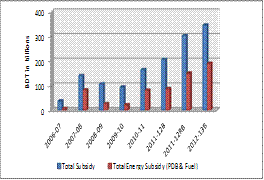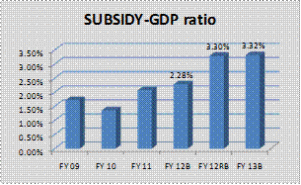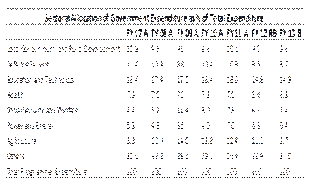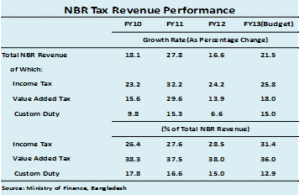The utilisation of Annual Development Programme (ADP) has been a common shortcoming of the government in the past.Chances are high that the trend will continue in fiscal year (FY)13 as well. However, significant gains have been made on two fronts. Because of the large size of the ADP allocation, despite the implementation shortfall, actual growth in ADP spending has been respectable in recent years. The pace of utilisation has increased significantly since FY10, compared to earlier years. The result of these two favuorable developments is a steady increase in implemented ADP size in relation to gross domestic product (GDP) in recent years. From the lowest level of close to 3.0 per cent of GDP in FY 09, the size of ADP is expected to increase by 1.5-2.0 percentage points to about 5.0 per cent of GDP in FY13. Nevertheless, there are other problems with the project selection process.

Source: Planning Commission and Ministry of Finance
There are too many projects under the ADP, constraining adequate funding and thereby limiting the capacity to complete the projects on time. Every year the size of the ADP is reduced significantly through a mid-year review exercise. But a large number of new projects averaging about 200 are added to the revised ADP. Furthermore, 507 projects have been added in FY12 Revised Budget (RB) without any fund allocation. These issues raise questions regarding both the adequacy of the selection process and quality of projects under the ADP.
Containing the surge in subsidy payments will remain a major challenge for fiscal management. The surge in subsidy payments in FY12 in particular was a major cause for excessive government borrowing from the domestic banking system. The pressures have been building up over the last three-years, and there is no sign for easing of subsidy payouts pressure.

Source: Medium-Term Budget Framework (MTBF)
In FY12, if we include the amount deferred to the next year, the amount of budgetary subsidy on an accrual basis would amount to 4.5 per cent of GDP.

The subsidy in the power sector has been particularly noticeable as the figure has been revised up by a considerable amount over the budgeted figure:
Fiscal costs associated with the power sector strategy far exceeded the original estimates;
If unchecked, costs will be much higher in the coming years because more rental power plants will be in operation; and
There will be longer than usual delays in implementing the medium and large power plants due to problem in securing finance.
The overall size of energy subsidies has grown rapidly in recent years due to rising import costs and inadequate cost recovery, undermining the fiscal position and overall macroeconomic stability. Notwithstanding significant fuel and electricity prices adjustments over the past year, more upward adjustments in petroleum and electricity prices would be necessary in FY13, given the projected import costs and available budgetary financing.
To contain fuel subsidies, the government has planned to move to an automatic adjustment formula by December 2012, which will ensure full pass-through of changes in international prices (an important International Monetary Fund or IMF programme benchmark). Implementation of such an automatic adjustment mechanism, if adopted, would help stabilise budgetary subsidy for fuel.
Subsidy reduction is a politically sensitive issue. Political consensus and support from the people will be critical for sustainable reduction in subsidies. A carefully prepared subsidy reduction strategy will help create awareness about this issue and engender political support for the cause.
It must also be recognised here that a power sector generation plan based on larger gas and coal fired plants is a must for the growth strategy and fiscal sustainability. Without plans for utilising domestic coal, BOP and fiscal sector vulnerabilities would persist.

The thrust on social sectors and safety net programmes for poverty alleviation has been maintained. A broad review of budgetary appropriations indicates that the thrust of the budget in FY13 is appropriately on the social sector. The top three recipients of budgetary allocations are for education, agriculture, local government and rural development, social security and welfare, and health. The share of defense spending has been following a declining trend, which is expected to continue in FY13. Allocation to agriculture has declined both in relative and real terms, perhaps due to the subsidy reduction strategy. The power and energy sector is the highest in terms of real growth in expenditure. Such social sector and expenditures on power sector if conducted consistently and properly could lead to substantial changes in both sectors and improve standard of living of the people.

On the revenue side, the target is ambitious but attainable if efforts to broaden the tax net through modernisation and strengthening of tax administration are sustained. The revenue target is ambitious because, except for two years FY08 and FY11, National Board of Revenue (NBR) had never recorded such a high target in recent years. Nevertheless, it is also true that NBR has exceeded its budget targets for the third consecutive year through FY12, which gives some confidence to this ambitious target.
As in recent years, realisation of the NBR revenue target would critically depend on success in maintaining the momentum in revenue generation from income tax and value added tax (VAT):
On the income tax side, a number of important revenue augmenting measures have been adopted, including: broadening the scope of tax withholding, effective operation of the alternative dispute resolution (ADR) mechanism, etc.
The downside risks relating to the FY13 revenue target primarily originate from the slower expected GDP growth.
There is no major change in the VAT regime in FY13. The thrust is primarily on strengthening and modernisation of tax administration to enhance efficiency of the VAT system.
Given Bangladesh’s relatively low VAT and income tax productivity, there is potential scope for realising the target if NBR modernisation efforts are continued.
Key Recommendations: Overall, the FY13 budget is ambitious requiring vigilance and perseverance for its effective implementation. Its proper implementation will require focusing on the following issues:
The targeted domestic borrowing from the banking system at Tk. 230 billion is already very high, and any shortfall in revenue, domestic non-bank financing through national savings bonds/certificates, and external financing will further increase recourse to bank financing and thereby crowd out the private sector and/or monetisation of borrowing undermining growth and inflation objectives.
On the expenditure side, limiting the subsidy bill to the budgeted level would require firm actions in the form of price adjustments for petroleum products and electricity. The measures must not be delayed, as was the case last year.
The authorities should prepare a comprehensive medium-term subsidy reduction strategy and hold public discussions on the strategy to mobilise public support for future cuts in subsidies.
Achieving the ambitious revenue target, in the face of slower than projected real economic growth, would entail strengthening tax administration and sustaining the reform process initiated in the VAT and direct tax fronts.
Accelerating the pace of foreign-funded project implementation and releasing the counterpart foreign financing would be keys to increasing ADP utilisation and reduce pressure on domestic bank financing. Making the positions of Project Directors more attractive by: giving them more authority in implementation and release of funds; rewarding them for good performance; and simultaneously holding them accountable for speedy project implementation. Linking disbursement of Taka counterpart funds to utilisation of foreign funds more effectively would encourage project management teams to focus on accelerating disbursement of foreign resources. [Dr. Ahsan Mansur is Executive Director, Policy Research Institute (PRI), Bangladesh. This policy note was presented at a recent policy dialogue in Dhaka, organised by PRI, Bangladesh.pri.bangladesh@gmail.com]
http://www.thefinancialexpress-bd.com/more.php?page=detail_news&date=2012-07-08&news_id=135798






